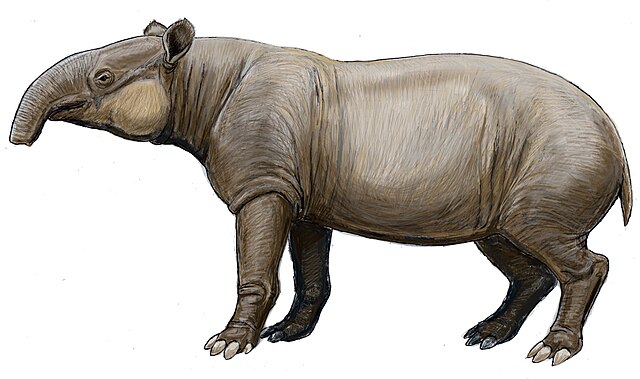Megaherbivores are large herbivores that can exceed 1,000 kg (2,200 lb) in weight. They first appeared 300 million years ago in the early Permian, in the form of synapsids. They were then replaced by megaherbivorous dinosaurs that went extinct in the Cretaceous-Paleogene extinction event. After this period, small mammalian species evolved into large herbivores in the Paleogene. During the Quaternary Extinction Event, megaherbivores disappeared on most continents on Earth. Recent megaherbivores include elephants, rhinos, hippos, and giraffes. There are nine extant species of terrestrial megaherbivores living in Africa and Asia. The African bush elephant is the largest extant species.
Hippopotamus is an extant megaherbivore.
Dinodontosaurus skeleton
Skeleton of Paraceratherium, a rhinocerotoid
Giraffe calves don't stay with their mothers, they sit down and hide for most of the day, and their mothers briefly visit to feed them.
Late Pleistocene extinctions
The Late Pleistocene to the beginning of the Holocene saw numerous extinctions of predominantly megafaunal animal species, which resulted in a collapse in faunal density and diversity across the globe. The extinctions during the Late Pleistocene are differentiated from previous extinctions by the widespread absence of ecological succession to replace these extinct megafaunal species, and the regime shift of previously established faunal relationships and habitats as a consequence. The timing and severity of the extinctions varied by region and are thought to have been driven by varying combinations of human and climatic factors. Human impact on megafauna populations is thought to have been driven by hunting ("overkill"), as well as possibly environmental alteration. The relative importance of human vs climatic factors in the extinctions has been the subject of long-running controversy.

Late Pleistocene in northern Spain, by Mauricio Antón. Left to right: wild horse; woolly mammoth; reindeer; cave lion; woolly rhinoceros
Mural of the La Brea Tar Pits by Charles R. Knight, including sabertooth cats (Smilodon fatalis, left) ground sloths (Paramylodon harlani, right) and Columbian mammoths (Mammuthus columbi, background)
The proportion of extinct large mammal species (more than or equal to 10 kg (22 lb)) in each country during the last 132,000 years, only counting extinctions earlier than 1000 years BP
Giant tapir (Tapirus augustus) restoration








